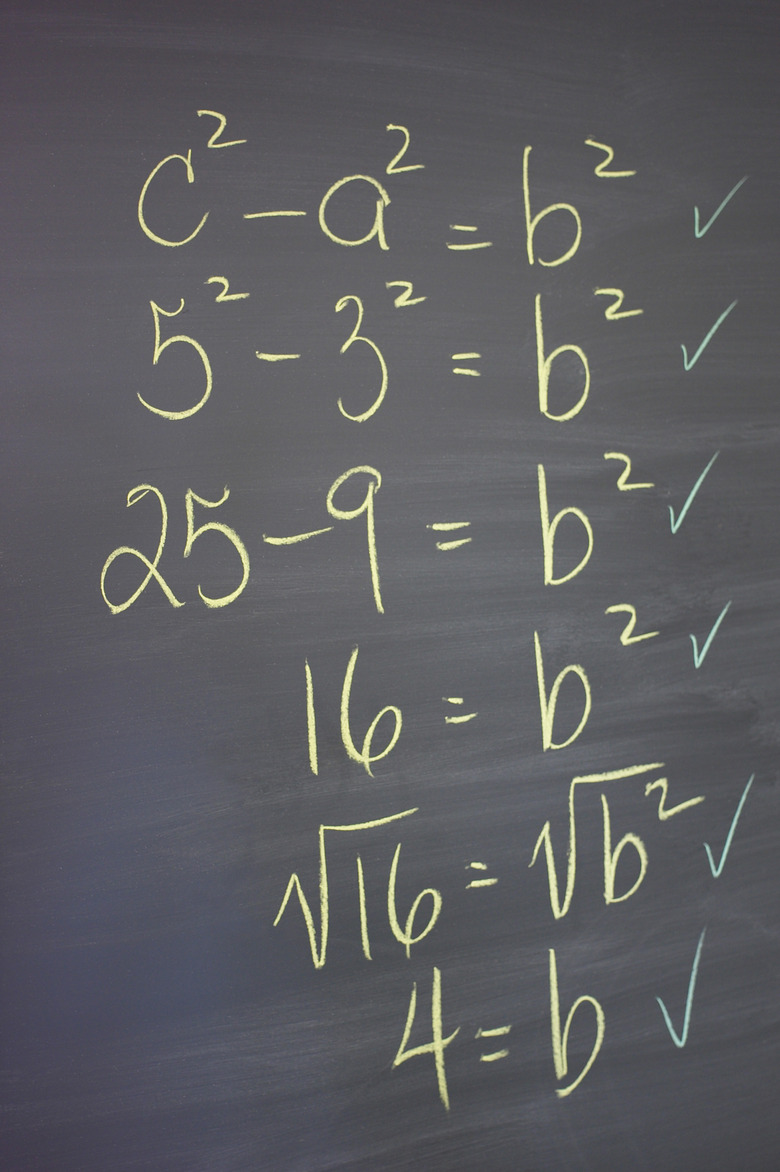How To Learn Algebra In Easy Steps
Algebra represents the first major conceptual leap in your math education, so it's small wonder that it's often intimidating to new students. But in truth, there are just two things you need to learn in algebra: The concept of variables, and how you can manipulate them. The easy way to learn algebra is exactly how your teachers will instruct you: One small step at a time, with lots of repetition to help each concept sink in so you'll be ready for the next.
TL;DR (Too Long; Didn't Read)
If you're feeling frustrated, take heart: That's a natural, though unpleasant, part of learning these new concepts. Don't be afraid to ask questions in class, because odds are good that other students are wondering the same thing. And always take advantage of your instructor's office hours and any tutoring services offered by your school or university; both help a lot.
An Algebra Introduction: The Basics of Variables
An Algebra Introduction: The Basics of Variables
The very first thing you'll have to master in algebra is the concept of a variable. Variables are letters that serve as placeholders for numbers whose value you don't know. So for example, in the equation 1 + 2 = x, the x is a placeholder for the 3 that should occupy the other side of the equation. The most common letters used for variables are x and y, although you can use any letter for a variable.
What You Can Do With Algebra Variables
What You Can Do With Algebra Variables
You can do absolutely anything with an algebra variable that you can do with a number. You can add them, subtract them, multiply them, divide them, take their root, apply exponents . . . you get the idea.
But there's a catch: While you know that 22 = 4, there's no way of knowing what x2 equals – because remember, that variable represents an unknown number. So instead of just solving the operations that you apply to variables, you have to rely on your knowledge of the properties of those operations, sometimes called the laws of mathematics.
For example, if you see something like 3(2 + 4), with a little basic math you can see that the answer is 3(6) or 18. But if you were facing 3(2 + y), you wouldn't be able to say the same thing – because while y might equal 4, it could also equal 1, 2, 3, -5, 26, -452 or any other number you can think of.
So you can't make assumptions about y's value. But you can apply the distributive law, which tells you that:
3(2 + y) = 6 + 3y or, to follow the convention of putting the variable term first when possible, 3y + 6. Sometimes that's as far as you'll get with an algebra problem; other times, you might be given enough information about the value of y to "solve for the variable," which means finding out which number value it represents.
Tricks for Solving for an Algebra Variable
Tricks for Solving for an Algebra Variable
When you tackle your first lessons in algebra for beginners, you'll learn some useful tricks for solving equations that involve variables. The most important concept to master is that when you're faced with an equation such as x = 2x + 4, you can do just about anything to any side of the equation – as long as you remember to do exactly the same thing to the entire other side of the equation.
Once you get that concept, you'll almost always follow a simple pattern to solve equations that involve a variable:
**First, isolate the variable term on one side of the equation.**
In the case of x = 2x + 4, you have a variable term on both sides of the equation. But if you subtract 2x from both sides of the equation, the variable term on the right will be cancelled out, leaving you with -x = 4.
**Next, isolate the variable itself.**
Recall that -x is understood to mean -1 × x. So to isolate the x variable on the left side of the equation, you have to perform the inverse of multiplying by -1. That means you'll divide by -1 – and remember, you have to perform the same operation on both sides of the equation. This gives you:
x = 4
**Combine like terms and simplify?**
With more complex equations, this is where you would combine like terms and perform any other simplifying possible. But in this case you've already found the value of your variable: x = -4.
TL;DR (Too Long; Didn't Read)
The other really handy trick in algebra is memorizing the standard form of equations that represent certain things. For example, **y = mx + b** is the standard form of a line. If you memorize that type of information, when you see an equation in the form **y = mx + b**, you'll be able to say to yourself "Ah! It's a line!" and then use the corresponding "algebra toolkit" your teacher has given you.
Cite This Article
MLA
Maloney, Lisa. "How To Learn Algebra In Easy Steps" sciencing.com, https://www.sciencing.com/learn-algebra-easy-way-4452686/. 28 May 2019.
APA
Maloney, Lisa. (2019, May 28). How To Learn Algebra In Easy Steps. sciencing.com. Retrieved from https://www.sciencing.com/learn-algebra-easy-way-4452686/
Chicago
Maloney, Lisa. How To Learn Algebra In Easy Steps last modified August 30, 2022. https://www.sciencing.com/learn-algebra-easy-way-4452686/
